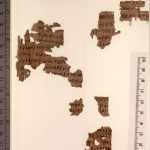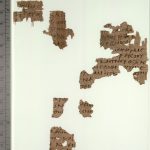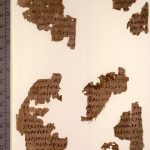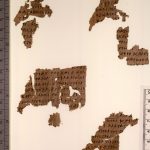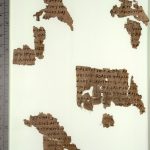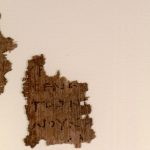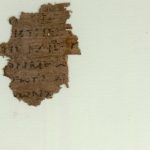| Artefact ID | 357 |
| TM ID | TM 65898 |
| Findspot (DEChriM ID) | 28 (al-Bahnasā) | Class | Textual |
| Material | Papyrus |
| Writing medium | Codex |
| Text content | Literary |
| Language | Greek |
| Description | P.Oxy. LXVI 4499; Gregory-Aland P115; Gregory-Aland 𝔓115 A large group of fragments containing the Book of Revelation (the Gospel of John; Apocalypse) 2-18 passim. The 26 fragments belong to 9 different folios, and earliest fragment probably came from the third folio of the codex; see ed. pr. The ed. pr. highlights a specially curious reading in verse xiii 18, where the papyrus fragment names 616 as the number of the Beast, contrasting the "666" found in the majority of the text witnesses (but agreeing with the MS C). Irenaeus (Adv.Haer. 5.3.1.) was aware of, and contested, this alternative reading already in the 2nd. c. This together with other proximities marks the text as representative of the A C text type; see Blumell / Wayment 2015: 143-144. The hand is described as informal and right-sloping with cursive tendencies in the ed. pr., yet it is otherwise labeled as an example of the severe style; see Clarysse / Orsini 2012: 457. The text has many instances of diareses and anastole (see e.g. p. 16 l. 129 and 133), and the ed. pr. notes that punctuation in the form of blank spaces occurs frequently before the beginning of a new verse. Ordinal and cardinal numbers are often written as figures, the line final nu is often abbreviated by a horizontal line. The text contains corrections made by both the original scribe and by another hand (i.e., a corrector) in brown ink; see ed. pr. The ed. pr. mentions the possibility of the the text having been copied into a pre-bound codex, due to the differences in width of the written areas where the recto (prob. odd pages) employs a wider area than the verso (prob. even pages). Another point of interest is the stylistic similarities of P24 and this text, which begins where P24 ends. The connection seems to be coincidental; see ed. pr. Other publications of the Book of Revelations include six papyrus witnesses and five parchment witnesses, i.a. P18 (=P.Oxy. VIII 1079, 3/4 c.), P24 (=P.Oxy. X 1230, 4th c.), P.Oxy. VIII 1080 (4th c.) and P.Oxy. LXVI 4500 (4th c.). The fragment partially overlaps with P24, P85 (=ZPE 4 (1969) 181-182) and P.Oxy. LXVI 4500, and presents the most extensive papyrus witness after P47 (=P.Chester Beatty III); see ed. pr. |
| Selection criteria | Literary genre (Biblical), Nomina sacra |
| Date from | 250 |
| Date to | 350 |
| Dating criteria | Palaeography. Dated to 275-375 by the ed. pr. on the basis of comparison with P.Oxy. VII 1016 (mid to late 3rd c.) and P.Herm. 4 (early 4th c.), and even earlier (200-250) by Jaroš 2006. For the most recent date, see Clarysse / Orsini 2012: 457. |
| Absolute/relative date | Relative date |
| Archaeological context | - |
| Accession number | Oxford, Sackler Library, Papyrology Rooms, P. Oxy. 4499. |
ARTEFACT IDENTIFIERS
Editio princeps:
• Gonis, N., J. Chapa, W.E.H. Cockle, D. Obbink, P.J. Parsons and J.D. Thomas, et al., eds. 1999. The Oxyrhynchus Papyri, part LXVI. Published by the Egypt Exploration Society in Graeco-Roman Memoirs. London. 10-35, no. 4499, plates no. 3-8 and 11-12.
Additional bibliography:
• Bauckham, Richard. 1993. The Climax of Prophecy: Studies On the Book of Revelation. Edinburgh: International Clark. 384-388.
• Blumell, Lincoln H. and Thomas A. Wayment. 2015. Christian Oxyrynchus: Texts, Documents and Sources. Waco, Texas. Papyrus no. 37.
• Clarysse, Willy and Pasquale Orsini. 2012. "Early new testament manuscripts and their dates: A critique of theological palaeography". Ephemerides Theologicae Lovanienses 88. 443-474.
• Comfort, Philip W. 2005. Encountering the Manuscripts: An Introduction to New Testament Paleography & Textual Criticism, Nashville, Tennessee: Broadman & Holman Publishers. 191.
• Comfort, Philip W. and David P. Barrett. 2001. The Text of the earliest New Testament manuscripts. Wheaton, Illinois. 664-677.
• Elliott, J. K. 1997. "The Distinctiveness of the Greek Manuscripts of the Book of Revelation". The Journal of Theological Studies N.S. 48 (1). 116-124.
• Malik, Peter. 2018. "The Greek Text of Revelation in Late Antique Egypt: Materials, Texts, and Social History". Zeitschrift für Antikes Christentum / Journal of Ancient Christianity 22 (3) 411-412.
• Head, Peter M. 2000. "Some Recently Published NT Papyri From Oxyrhynchus: An Overview and Preliminary Assessment" Tyndale Bulletin 51 (1). 15.
• Jaroš, Karl. 2006. Das Neue Testament nach den ältesten griechischen Handschriften (CD-Rom). 4619-4713, no. 2.61.
• Luijendijk, AnneMarie. 2010 "Sacred Scriptures As Trash: Biblical Papyri From Oxyrhynchus". Vigiliae Christianae 64 (3). 247-248., 250-251.
• Nevius, Richard C. 1997. "Papyri Witnesses to the Text of the Nomina Sacra in the Apocalypse". PapCongr. XXI. 750—755.
• Nicklas, Tobias. 2012. "The Early Text of Revelation". The Early Text of the New Testament. Hill, Charles E. and Michael J. Kruger, eds. 235.
• Parker, David C. 2000. "A New Oxyrhynchus Papyrus of Revelation: P115 (P. Oxy. 4499)." New Testament Studies 46 (2). 159-174.
• Parker, David C. 2008. "A New Oxyrhynchus Papyrus of Revelation: P115 (P. Oxy. 4499)." Manuscripts, Texts, Theology. Collected Papers 1977-2007. 73-92.


 Json data
Json data